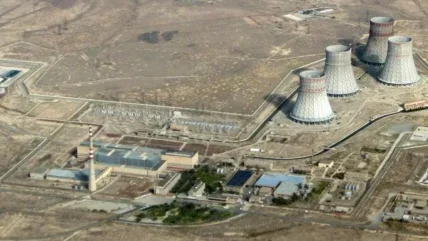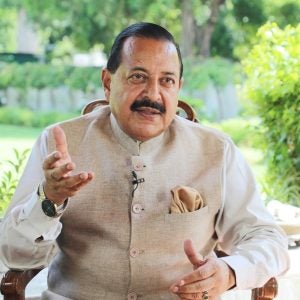
Among the options for a new NPP in Armenia, the project for a Russian unit of 1,000-1,200 MWe is the best developed, according to Karen Sargsyan, Advisor at the Ministry of Territorial Administration & Infrastructure (MTAI). He was speaking at a panel discussion on the prospects for nuclear energy in Armenia organised by Rosatom and the Ministry. Sargsyan recalled that at the beginning of this year, a pre-feasibility study (preliminary feasibility study) was prepared for Armenia for the construction of a plant with a VVER-1200 reactor. Armenia and Russia signed an interstate agreement to build a 1,000-1,200 MWe plant and in May, Armenian Prime Minister Nikol Pashinyan and Rosatom Director General Alexey Likhachev held talks in Yerevan on the possible construction of a new NPP.
We are talking about a new modification of this type of station – a generation 3+ design with four levels of protection against emergencies and accidents, he specified. There is very little time to make a decision, he noted, because the construction of the station will take at least 10 years, and a lot of work needs to be done meanwhile to further extend the life of the existing station. The first stage of the extension made it possible to extend the life of the NPP from 2016 to 2026. Another 10-year extension until 2036 is now being considered.
The currently operating Armenian NPP (ANPP) at Metsamor was built in the 1970s with two Soviet-supplied VVER-440-V230 units, but was closed following a devastating earthquake in 1988. However, unit 2 was recommissioned with Russian help in 1995 following severe energy shortages. In March 2014, the Armenian government decided to extend the plant’s service life to 2026. Most of the overhaul (until 2019) was funded by an interstate loan from Russia. Construction of a new nuclear plant has long been part of Armenia’s overall plan, although finance has proved to be an obstacle. Likhachev confirmed Rosatom’s continued support for co-operation and extension of the operating life of the NPP was viewed as a priority.
Before the start of any construction, significant design work will be needed. “I think that a decision may be made in the near future. Moreover, the pre-feasibility study is already ready from the Russian side, I have not seen anything from other parties yet,” Sargsyan said. However, other projects are being considered in parallel. A working group has been set up under the Ministry, which is discussing the advantages and disadvantages of French, South Korean, American and other possible technologies, he specified.
ANPP Director Movses Vardanyan said Armenia should begin considering the construction of a new power plant today. “In this regard Armenia is a specific country and has several demands,” he said. “First of all, the issues related to safety and seismic resistance are important to us, we also consider financial and logistic issues and many other aspects. As you know, in February 2023 our partners at the Rosatom Energy Projects submitted the preliminary technical-economic substantiation of building two 1200 MW reactors in Armenia. They take into consideration all our demands and issues, and we already have that project on hand. We are also working with our South Korean partners who have offered 1,000 and 1,400 MWe reactors, as well as small modular reactors (SMRs). We are also studying a French variant as well as American SMRs. I once again emphasise that we will prioritise safety, financial expediency and logistics.”
MTAI has set up a working group “for the purpose of discussing the matters related to the expediency of deploying small modular reactors, as well as to carry out analyses and define the sequence of further steps in order to select the necessary technologies”. According to Minister Gnel Sanosyan, there is a lot of work to be done: “About two years is needed for preparatory work, from 8 to 10 years for construction.” He added that it is necessary to understand what capacity the new NPP should have, and this must be decided by taking into account many factors – not for a short period, but for the next 100 years.
“For example, we must calculate how much electricity we will supply to Iran, whether we will supply it or not, whether we will supply electricity to Georgia. We need to understand what the relations between Armenia and Turkey will be like, whether Turkey will buy electricity from Armenia, because now the eastern regions of Turkey need it,” he added. Sanosyan said it is also necessary to calculate volumes of local consumption to assess the scale of dependence on the NPP. While the Russia project is well advanced, the USA is now proposing the construction of SMRs. The Minister said this proposal has not yet been studied from a technical point of view, it may take several months. However, he gave assurances that by the end of the year the Armenian government would “decide on the issue of capacity”.
Suren Bznuni, a specialist in nuclear and radiation safety, considers the existence of an “economic justification” and safety issues to be the most important consideration. He said it is necessary to build a safe and economically profitable reactor, regardless of whether it is Russian or American. A nuclear power plant with a capacity of 1,000 MWe, in his opinion, could be problematic for Armenia in terms of grid stability, given that the current NPP is only 400 MWe.
ANPP Board member Vahram Petrosyan believes Armenia would do better with two smaller plants each with a capacity of 500-600 MWe. He noted that Armenia’s total electricity demand does not exceed 1,200 MWe and that hydro, solar and thermal plants can easily make up the difference. “A high-capacity nuclear power plant can become a headache for the country. We must consider all options and send the right order to the government,” Petrosayn told Hetq.
However, UN National Expert on Energy Ara Marjanyan has said that building a new nuclear reactor at Metsamor is essential to enable Armenia to constantly generate nuclear power and that a new 1,000-1,200 MWe reactor would be required by 2036. He stressed that the new reactor must be completed before decommissioning the existing one. He noted that under the agreement concluded with Russia a roadmap is to be developed and a final decision is to be made on the type and other technical parameters of the reactor. The construction work will commence by the end of 2024 or early 2025 and the cost is estimated at $3-5bn. “I think this is a reasonable expenditure, and it is imperative for Armenia to have constant nuclear generation on its territory. I think the construction will take 10-12 years,” he said.
Russia Prime Minister Mikhail Mishustin said recently that Russia is ready to discuss the financial issues and parameters of building NPPs in the territories of Eurasian Economic Union members, including Armenia. He was addressing the Eurasia Is My Home exhibition which was also attended by Prime Minister Pashinyan. The attendees were briefed on Rosatom’s two-unit VVER-1200 project in Belarus. The first unit is already operational while the second is undergoing tests. Mishustin told Pashinyan that Belarusian companies financed just over 40% of the costs. Pashinyan reportedly noted that Rosatom was not offering reactors with capacity lower than 1,200MWe. In response, Rosatom Director General Likhachev told Pashinyan that Rosatom can build reactors with capacities of 1,000, 600 or 400 MWe, but it would be more expensive.
Image: Metsamor nuclear power plant (courtesy of ANPP)






